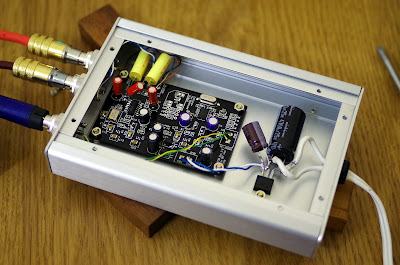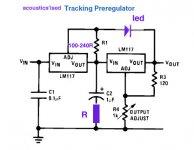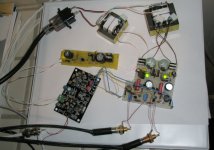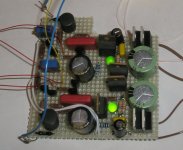So, you've just excited my curiosity. I'll be patient...Mmm, I get the impression you want to know more
Just wait. Maybe it will happen, maybe it won't.
Can't believe you would go the USB way ?
Still mute ?
Last edited:
Mmm, I get the impression you want to know more
Just wait. Maybe it will happen, maybe it won't.
There must be some nice new thing going !
There may be some demand for a USB DAC. I've been using the Twisted Pear USB DAC/Receiver (which, I think, is one of the better ones) for a long time. Recently I purchased a dedicated soundcard, and was surprised to find that the analog out from the soundcard was better (lower and fuller bass) than from the TP USB DAC. I suspect that the power supplied by the USB bus is just horrible, and a USB DAC would benefit from a separate power source. Just a guess . . .
Whatever JP dreams up I'm sure will be great, and I'll probably get in on the GB!
Whatever JP dreams up I'm sure will be great, and I'll probably get in on the GB!
Hi Skylab,
For you information, the current modifications on my EUVL 9022 DAC are listed as follows.
1. Add a Scientific Conversion pulse transformer in the SPDIF input.
2. Swap the 75ohm resistor in the SPDIF input with a Naked Z-foil TX2575 resistor.
3. Swap the output filter caps with a pair of Relcap RT tin-foil/polystyrene film caps.
4. Swap the caps in VREG, NEG, and CN-CP with Black Gate N/NX caps.
All in all, the original setting from Patrick is well-tweaked and sounds pretty good.
I just exchanged some parts to fit my personal preference.
Hi Marlowe,
Got hold of a SC944-05 for the SPDIF but not yet implemented. I changed C9 to BG N 1uf, C32 changed to BG STD 100uF (couldn't get the N). Will try Caddock for R1 (don't have z-foil for 75R), got 2 MultiCap 6200pf for C14 (ran out of 4700pf). Will report back after all these done and see how it goes.
Best regard
Hi syklab,
The improvement of the SC944-05 depends on the noise level of the source.
I built my second version of the WM8804/ES9023 DAC last week. The circuit is all the same, but more audio grade caps were installed.
The Nichicon FPCAPs are replaced with Nichicon VR, the WM8804 supplies are Sanyo OS-CON SP, the caps around ES9023 are changed to small Black Gate N/NX, and the LPF caps are RelCap RT now.
The sound of second version is more relaxing and enjoyable.

The improvement of the SC944-05 depends on the noise level of the source.
I built my second version of the WM8804/ES9023 DAC last week. The circuit is all the same, but more audio grade caps were installed.
The Nichicon FPCAPs are replaced with Nichicon VR, the WM8804 supplies are Sanyo OS-CON SP, the caps around ES9023 are changed to small Black Gate N/NX, and the LPF caps are RelCap RT now.
The sound of second version is more relaxing and enjoyable.
The improvement of the SC944-05 depends on the noise level of the source.
????? Our marketing lady says you stole that line from her
Using BG NX is a clear improvement. Good industrial quality caps will do just fine but NX is the best you can use in this DAC.
Try out as many caps as you like as long as they're small and have short leads. Any large cap with supposedly better dielectrics (but as large as a penlight battery with long wires) will perform worse than the recommended types. Compact is important here.
Last edited:
They might be better in absolute terms and by experience in other applications. In general physical larger caps do sound better in analog applications but please use your oscilloscope and verify/check. Polystyrene, polypropylene and polycarbonate caps sound better than polyester (with some exceptions) but output filter caps must be small with short lead wires in this DAC. The small MKP and FKP 5 mm are good candidates. If one wants to try larger caps it would be better to solder them on the output RCA connectors far from the XO. We moved the output connectors because of this to the back, normally the PCB is mounted with the output connections at the back of the case so output wiring is relatively far from the XO. Not wanting to be the ever-critical Mr. Knowitall but the XO is very close to the RCA in your case.
Maybe you will think I am pushing my opinion (I am, I know) but in this particular application all parts must be physical small for optimal measured performance. I like to test it by listening too but that might be deceiving in some cases. There is a 50 MHz XO on the board that just loves to send its waves to adjacent antennas....
Maybe you will think I am pushing my opinion (I am, I know) but in this particular application all parts must be physical small for optimal measured performance. I like to test it by listening too but that might be deceiving in some cases. There is a 50 MHz XO on the board that just loves to send its waves to adjacent antennas....
Last edited:
Hi jean-paul,
Yes, the bigger caps have the shortcoming of longer leads.
In the case of Relcap RT vs. MKS in this DAC, however, I like the sound of Relcaps more.
Okay, I will try other smaller caps in this place.
The Amtrans AMCH polypropylene film caps are also very good and much smaller though I usually prefer PS to PP.
Amtrans AMCH Series Film & Foil Capacitors
Yes, the bigger caps have the shortcoming of longer leads.
In the case of Relcap RT vs. MKS in this DAC, however, I like the sound of Relcaps more.
Okay, I will try other smaller caps in this place.
The Amtrans AMCH polypropylene film caps are also very good and much smaller though I usually prefer PS to PP.
Amtrans AMCH Series Film & Foil Capacitors
Found this Amtrans from taobao but no AMCzh, only mica for 4700pf.
ÈÕ±¾Amtrans ¸ß¼¶ÒôÏìרÓõçÈÝ 0.01UF/630V 50Ôª/Ö»-ÌÔ±¦Íø
ÈÕ±¾Amtrans ¸ß¼¶ÒôÏìרÓõçÈÝ 0.01UF/630V 50Ôª/Ö»-ÌÔ±¦Íø
error in build?
Jean-Paul,
I've been playing around with the version of this DAC that I built earlier in the summer and I think I've found an error in the build guide. If you check the polarity of C32, the 10uF electrolytic capacitor that connects to Neg on the ESS9023, you'll see that + polarity of the capacitor is hooked to Neg. Neg is a negative voltage generated on the 9023 - I measured it and it's ~ -3.x volts. I don't remember exactly what x is right now.
I swapped the polarity of C32 on my DAC and the sound quality got quite a bit better. I'll write more about this in another note, but I wanted to ask you to check this and let me know if you agree with my finding.
Thanks,
---Gary
Jean-Paul,
I've been playing around with the version of this DAC that I built earlier in the summer and I think I've found an error in the build guide. If you check the polarity of C32, the 10uF electrolytic capacitor that connects to Neg on the ESS9023, you'll see that + polarity of the capacitor is hooked to Neg. Neg is a negative voltage generated on the 9023 - I measured it and it's ~ -3.x volts. I don't remember exactly what x is right now.
I swapped the polarity of C32 on my DAC and the sound quality got quite a bit better. I'll write more about this in another note, but I wanted to ask you to check this and let me know if you agree with my finding.
Thanks,
---Gary
addition of JG buffer
I just finished building a version of Joachim Gerhard's buffer for this DAC. This buffer has been discussed in another thread and there's been a group buy under way. I'm not the most patient person in the world, so I built a version point to point on a perf board. It's powered from a 14v+14v x 0.42a transformer. The power supply uses a LM317 with another LM317 as a tracking preregulator along the lines discussed here: Using 3-pin regulators off-piste: part 4.
Two of these give +- 14.5v. The buffer uses 2SK170BLs cascoded with J111 jfets and has an LC prefilter. When I first hooked it up, I was expecting a big improvement over the simple ES9023 and it did sound better, but still not what I was hoping for. So I decided to dig into the DAC and see where there might be further room for improvement. First, I changed the clock cap (C8) from the ceramic caps of the original build guide to the 4.7uf tantalum that have been strongly recommended recently. This gave a small improvement but still wasn't as good as I expected. Then I studied the schematic and discovered that C32, the cap on the NEG pin of the ES9023 had the wrong orientation, as mentioned in my earlier message. Changing the polarity of C32 gave a big improvement in sound quality and I am now quite pleased with the sound. Now I need to take a listen to the other version of this DAC that I've built without the buffer and with the polarity fix for C32. But I'm short a few parts, so that will have to wait a while before I can do that. Until then, I'll just enjoy this version of the DAC, which seems to be sounding very good right now.
---Gary
I just finished building a version of Joachim Gerhard's buffer for this DAC. This buffer has been discussed in another thread and there's been a group buy under way. I'm not the most patient person in the world, so I built a version point to point on a perf board. It's powered from a 14v+14v x 0.42a transformer. The power supply uses a LM317 with another LM317 as a tracking preregulator along the lines discussed here: Using 3-pin regulators off-piste: part 4.
Two of these give +- 14.5v. The buffer uses 2SK170BLs cascoded with J111 jfets and has an LC prefilter. When I first hooked it up, I was expecting a big improvement over the simple ES9023 and it did sound better, but still not what I was hoping for. So I decided to dig into the DAC and see where there might be further room for improvement. First, I changed the clock cap (C8) from the ceramic caps of the original build guide to the 4.7uf tantalum that have been strongly recommended recently. This gave a small improvement but still wasn't as good as I expected. Then I studied the schematic and discovered that C32, the cap on the NEG pin of the ES9023 had the wrong orientation, as mentioned in my earlier message. Changing the polarity of C32 gave a big improvement in sound quality and I am now quite pleased with the sound. Now I need to take a listen to the other version of this DAC that I've built without the buffer and with the polarity fix for C32. But I'm short a few parts, so that will have to wait a while before I can do that. Until then, I'll just enjoy this version of the DAC, which seems to be sounding very good right now.
---Gary
Attachments
- Status
- This old topic is closed. If you want to reopen this topic, contact a moderator using the "Report Post" button.
- Home
- Group Buys
- ES9023 / WM8804 S/PDIF DAC Group Buy


